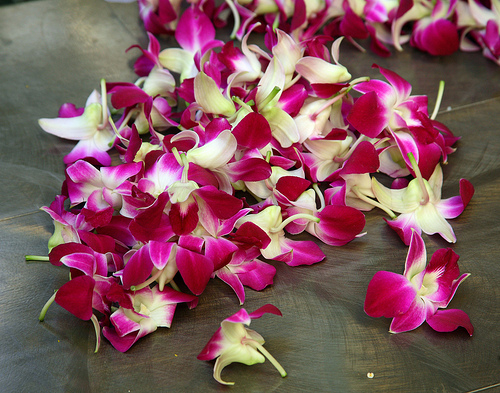A lei is a beautiful necklace or wreath usually made of tropical flowers, though there are also versions made of rare shells or other materials. The most popular choices for floral leis include orchids or the Plumeria. Both are large, fragrant blossoms.
Leis are an ancient Hawaiian custom; Captain Cook saw Hawaiians wearing leis in 1779, but the tradition is believed to date back several centuries further. In ancient times in Hawaii, a special lei was worn as a symbol of the wearer’s social rank. The type of flower or construction of the lei differentiated the wearer’s rank. Today, Hawaii’s governor or other important figures often wear leis for holidays or significant public appearances.
In both ancient and modern times, leis have been given or worn for important occasions ranging from births and deaths to graduations, victories, or religious ceremonies. A religious lei ceremony would be used to ask the gods for fertile crops or safety when traveling. Different colors or flower varieties could be incorporated depending on the symbolism of the occasion.
The traditional Hawaiian lei is given not only during important occasions but also as a symbol of welcoming, respect, love, or appreciation. Though in centuries past lei-giving was usually reserved for particular occasions, today the lei has many different meanings, and is seen at nearly every public occasion on the islands. Though not part of the ancient Hawaiian way of giving leis, today the giving of a lei is often accompanied by a kiss on the cheek, particularly if the recipient knows the lei giver well.
One occasion in Hawaii where leis are almost always seen is a wedding. Leis are incorporated into weddings in several different manners. The couple may exchange leis during the ceremony, as a symbol of their love and commitment. Before the ceremony itself, the wedding officiate may hold or bless the flowers. Instead of giving leis to each other, the couple can also give them to family members, symbolizing the joining of the two families. They may be used in place of corsages and boutonnieres for the wedding party, or given as wedding favors to the guests. When given to wedding guests, the lei symbolizes the couple’s appreciation for your support.
Leis are often given to visitors of the islands as a symbol of the “spirit of aloha.” Difficult to translate, ‘aloha’ means a greeting, a farewell, joy, hope, love, and other positive feelings. Leis made of beautiful flowers are a non-verbal expression of the ‘aloha’ spirit. Today, there are almost no restrictions on lei giving; leis are given on dozens of different occasions, and for a wide range of symbolic reasons.
All leis are hand-woven, and represent a gift of love. This special gift should be treasured; some are actually quite rare because of the variety of flower used. Receiving a lei made of one of these flower species is a very high honor; most are made specifically for adorning important statues or monuments.
If you have received a flower lei, wear it around your neck, wrapped around your neck, or on the brim of a hat. Do not wear the lei around your neck if you are pregnant; according to superstitious beliefs, this symbolizes the tangling of the umbilical cord. The lei should not be removed when you are in the presence of the lei giver. Never refuse the offering of a lei, which is considered rude. After the flowers have wilted, return it to the place where the flowers were gathered, hang it in a tree, bury it, or otherwise return it to the earth, but do not throw it in the trash.


